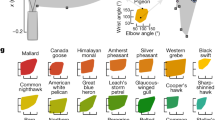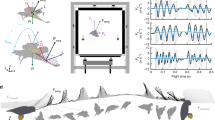Abstract
The vast majority of pterosaurs are characterized by relatively large, elongate heads that are often adorned with large, elaborate crests. Projecting out in front of the body, these large heads and any crests must have had an aerodynamic effect. The working hypothesis of the present study is that these oversized heads were used to control the left–right motions of the body during flight. Using digital models of eight non-pterodactyloids (“rhamphorhyncoids”) and ten pterodactyloids, the turning moments associated with the head + neck show a close and consistent correspondence with the rotational inertia of the whole body about a vertical axis in both groups, supporting the idea of a functional relationship. Turning moments come from calculating the lateral area of the head (plus any crests) and determining the associated lift (aerodynamic force) as a function of flight speed, with flight speeds being based on body mass. Rotational inertias were calculated from the three-dimensional mass distribution of the axial body, the limbs, and the flight membranes. The close correlation between turning moment and rotational inertia was used to revise the life restorations of two pterosaurs and to infer relatively lower flight speeds in another two.






Similar content being viewed by others
References
Alerstam T, Rosén M, Bäckman J, Ericson PGP, Hellgren O (2007) Flight speeds among bird species: allometric and phylogenetic effects. PLoS Biol 5(8):e197. https://doi.org/10.1371/journal.pbio.0050197
Anderson JD Jr (1978) Introduction to flight, 9th edn. McGraw-Hill Inc, New York
Andres B, Langston W Jr (2021) Morphology and taxonomy of Quetzalcoatlus lawson 1975 (Pterodactyloidea: Azhdarchoidea). J Vertebr Paleontol 41(sup1):142
Bennett SC (1992) Sexual dimorphism of Pteranodon and other pterosaurs with comments on cranial crests. J Vertebr Paleontol 12:422–434
Bennett SC (2001) The osteology and functional morphology of the Late Cretaceous pterosaur Pteranodon. Palaeontogr Abt A 260:1–153
Bennett SC (2003) New crested specimens of the Late Cretaceous pterosaur Nyctosaurus. Paläontol Z 77:61–75
Bennett SC (2007) A second specimen of the pterosaur Anurognathus ammoni. Paläontol Z 81(4):376–398
Bramwell CD, Whitfield GR (1974) Biomechanics of Pteranodon. Philos Trans R Soc Lond 267:503–581
Butler RJ, Barrett PM, Gower DJ (2009) Postcranial skeletal pneumaticity and air-sacs in the earliest pterosaurs. Biol Let 5:557–560
Claessens LPAM, O’Connor PM, Unwin DM (2009) Respiratory evolution facilitated the origin of pterosaur flight and aerial gigantism. PLoS ONE 4:e4497
Eaton GF (1910) Osteology of Pteranodon. Memoirs Connecticut Acad Arts Sci 2:1–18
Elgin RA, Grau CA, Palmer C, Hone DWE, Greenwell D, Benton MJ (2008) Aerodynamic characters of the cranial crest in Pteranodon. Zitteliana B28:167–174
Halliday D, Resnick R, Walker J (1993) Fundamentals of physics, 4th edn. John Wiley & Sons Inc, New York
Hasegawa Y, Carpenter K, Zhiming D, Xing X (2006) The Gigantic Dinosaur Expo 2006 - Official Guidebook. NHK Promotions Co., Ltd
Henderson DM (2002) The eyes have it: the sizes, shapes, and orientations of theropod orbits as indicators of skull strength and bite force. J Vertebr Paleontol 22(4):766–778
Henderson DM (2010) Pterosaur body mass estimates from three-dimensional mathematical slicing. J Vertebr Paleontol 30(3):768–785
Heptonstall WB (1971) An analysis of the flight of the Cretaceous pterodactyl Pteranodon ingens (March)[sic]. Scott J Geol 7(1):61–78
Hone DWE, Naish D, Cuthill IC (2011) Does mutual sexual selection explain the evolution of head crests in pterosaurs? Lethaia 45:139–156
Li WuX, Zhang F (2008) The Chinese fossil reptiles and their kin, 2nd edn. Science Press, Beijing
Lü J, Unwin DM, Jin X, Liu Y, Ji Q (2010) Evidence for modular evolution in a long-tailed pterosaur with a pterodactyloid skull. Proc R Soc B 277(1680):383–389
Lü J, Unwin DM, Deeming DC, Jin X, Liu Y, Ji Q (2011) An adult-egg association, gender, and reproduction in pterosaurs. Science 331:321–324
Paul GS (2002) Dinosaurs of the air: the evolution and loss of flight in dinosaurs and birds. Johns Hopkins University Press, Baltimore
Proctor NS, Lynch PJ (1993) Manual of ornithology. Yale University Press, New Haven
Rodrigo V, Pêgas RV, Zhou X, Jin X, Wang K, Ma W (2023) A taxonomic revision of the Sinopterus complex (Pterosauria, Tapejaridae) from the Early Cretaceous Jehol Biota, with the new genus Huaxiadraco. PeerJ 11:e14829. https://doi.org/10.7717/peerj.14829
Schmidt-Nielsen K (1984) Scaling: why is animal size so important. Cambridge University Press, Cambridge
Stein RS (1975) Dynamic analysis of Pteranodon ingens: a reptilian adaptation to flight. J Paleontol 49:534–548
Unwin DM (2005) The Pterosaurs from deep time. Pi Press, New York
von Kripp D (1943) Ein lebensbild von Pteranodon ingens auf flugtechnischer Grundlage. Nova Acta Leopoldina N.F. 12(83):16–32
Wellnhofer P (1991a) The illustrated encyclopedia of pterosaurs. Salamander Books, London
Wellnhofer P (1991b) Weitere Pterosaurierfunde aus der Santana-Formation (Apt) der Chapada do Araripe, Brasilien. Palaeontographica, A, 215; Lfg. 1–3, 43–101. Stuttgart
Witmer LM, Chatterjee S, Franzosa J, Rowe T (2003) Neuroanatomy of flying reptiles and implications for flight, posture and behaviour. Nature 425:950–953
Witton MP (2013) Pterosaurs: natural history, evolution, anatomy. Princeton University Press, Princeton
Xing L, Wu J, Lu Y, Lü J, Ji Q (2009) Aerodynamic characterstics of the crest with membrane attachment on Cretaceous pterodactyloid Nyctosaurus. Acta Geol Sin 83(1):25–32
Acknowledgements
I thank Mark Witton (University of Portsmouth) for providing the new Thalassodromeus sethi that was used as part of this study. I thank Jaime Wong (Department of Mechanical Engineering, University of Alberta) for bringing Eqs. 1 and 3 to my attention, for raising the possibility of a combined stability and turning function for a pterosaurian head plus cranial crest, and for reading a draft of the MS. The comments and suggestions of the three reviewers - Rodrigo Pêgas and two anonymous ones - made for a much improved paper.
Author information
Authors and Affiliations
Corresponding author
Ethics declarations
Conflict of interest
The author declares no competing interests.
Supplementary file1 (PDF 1512 KB)
Additional information
Communicated by: Rodrigo Temp Müller
Publisher's Note
Springer Nature remains neutral with regard to jurisdictional claims in published maps and institutional affiliations.
Supplementary Information
Below is the link to the electronic supplementary material.
Rights and permissions
Springer Nature or its licensor (e.g. a society or other partner) holds exclusive rights to this article under a publishing agreement with the author(s) or other rightsholder(s); author self-archiving of the accepted manuscript version of this article is solely governed by the terms of such publishing agreement and applicable law.
About this article
Cite this article
Henderson, D.M. Using your head — cranial steering in pterosaurs. Sci Nat 111, 29 (2024). https://doi.org/10.1007/s00114-024-01915-7
Received:
Revised:
Accepted:
Published:
DOI: https://doi.org/10.1007/s00114-024-01915-7




